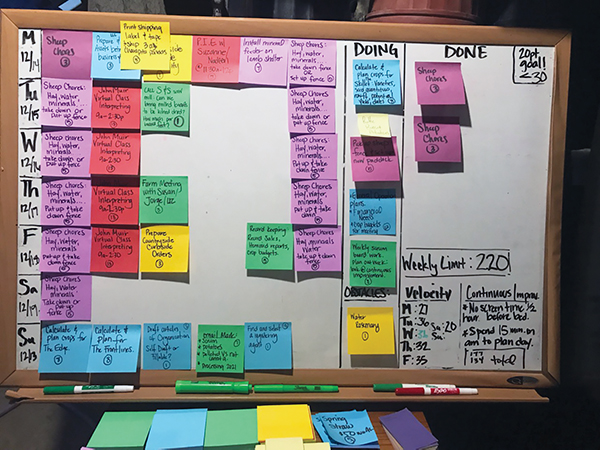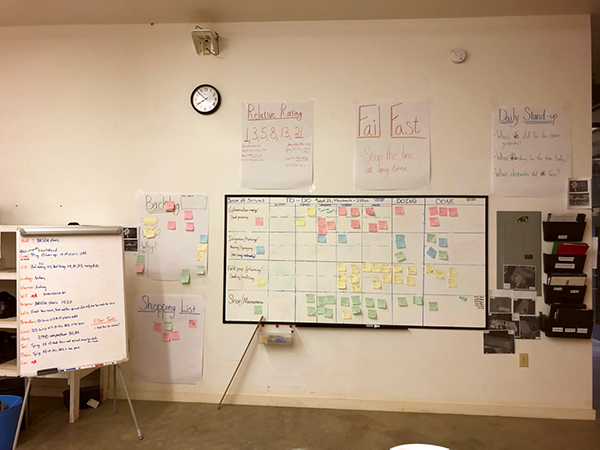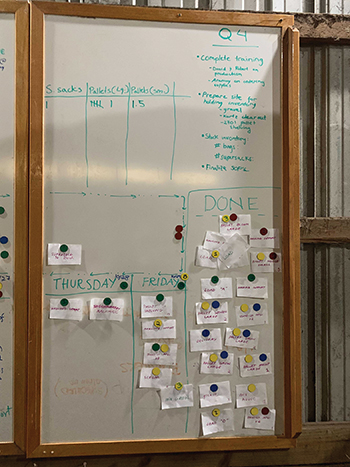There’s nothing sustainable about sustainable farming when it comes to personal maintenance. The hours are too long, demands too time-sensitive, and physical requirements exceed healthy levels — especially in the summer heat.
I had been a farm manager for more than 10 years when I decided the lack of sustainability in my farm life needed an alternative management approach. I spent most of the previous 10 years wishing for more hours in the day and was convinced that everything was top priority and had to be done first. Ultimately, I felt I was not achieving or accomplishing anything.
 Kelly’s Scrum board divides her to-do column by days and accurately tracks velocity and goals for improvement. Photo by Kelly Powers of Powers Acres.
Kelly’s Scrum board divides her to-do column by days and accurately tracks velocity and goals for improvement. Photo by Kelly Powers of Powers Acres.
Needless to say, this took a toll on my mental and emotional health. No matter how hard I worked, I felt like a failure. Relationships, relaxation and self care always fell by the wayside; the farm was always the most important element in my life and required the preponderance of my energy and abilities. Work-life balance was the punch line to the joke of employees requesting time off.
It was at this point — frazzled, worn down, and anxious — that I found the Agile project management concept called Scrum. Sure, I had all the tools and resources to be a successful farm manager: a decade of experience, lean farming principles, spreadsheets, calendars, and a dedicated crew.
Despite all of that I was lacking a system. A system that would best use the tools and resources, while balancing the human element. Scrum achieved this by focusing the farm season into a project framework and leveling the time commitment, seasonal expectations, and physical toll of farming.
This concept was originally developed in the 80s when printer production companies needed their development teams to create rapid improvements to their copiers. Fast forward to the 90s when Jeff Sutherland and colleagues published books on the concept and began training programs to empower self-managed teams in complex software development. Now, Scrum is used all over the world from auto manufacturing to the military and small business.
 This Scrum board was used to break down user stories of color-coded departments within a larger company. Photo by Andrea Heim.
This Scrum board was used to break down user stories of color-coded departments within a larger company. Photo by Andrea Heim.
Like any farm manager, I wanted to accomplish as much as possible on a daily basis. Since the beginning of my farming career, I had found it difficult to set realistic expectations and prioritize. These inefficiencies led to poor self-maintenance, excessive work hours, lack of capacity and overall unhappiness.
That’s why three core artifacts of Scrum (user stories, a scrum board, and velocity) stood out to me as they addressed expectations and priority setting head on. They help to treat the farm season as one large project and break it down into more manageable subsets.
To begin, user stories capture the needs and desires of the end user of a product. End users can include CSA or farm market customers, wholesale buyers, interns, other company departments, and members of a community garden. User stories create the framework for where to focus time and energy.
Simply ask your end users to fill in the blanks for the following sentence: As a ___<role>___, I want ___<goal>___, so that ___<benefit> ___. Avoid making your own assumptions about these answers. Taking the time to have a conversation and gain feedback is critical to a valuable user story.
The concept of a user story is directly linked to the lean farming principle of cutting out muda (anything that does not add value). If the end user of your farm or product doesn’t value it, don’t do it, or minimize the heck out of it. Once you have the stories, gather them into broader statements that represent each group of end users. These stories affect your prioritization of tasks throughout the season.
Some examples of user stories are: As a CSA customer I want my fresh cut flower bouquets to last a full week so I never go a day without flowers on my table. As a chef I want on-time delivery of exactly what I ordered every week so I don’t have to worry about ordering elsewhere. As an employee I want a predictable schedule so that I can have a life outside of work, even in the middle of the summer.
The second artifact of Scrum that helps with prioritization and expectation setting is the scrum board, a type of kanban or time-bound organizational chart. This board can be any surface on which tasks can be visualized and rearranged within a time span.
Examples include a wall with post-it notes, a dry erase board with magnets, or virtual on an app like Trello. The board allows everyone on a team to see what is being accomplished in real time, and how much is still to be done within a set time frame (typically one to four weeks). The scrum board is divided into sections that include a backlog, to-do, doing, and done.
In developing a scrum board, tasks are the centerpiece. Tasks are developed using user stories as a guide. If the user stories indicate that your CSA customer wants fresh flowers that last a week, then you focus tasks on succession planting that deliver weekly harvests, selecting only varieties that will last a full week in a vase; and if they are going in a vase, perhaps you don’t worry about spraying the last planting for mildew because those leaves will be trimmed off anyway.

 Here’s how a multi-person crew uses color-coded magnets to assign tasks to specific individuals on their Scrum board. Photo by Aramay Moss of Tilth Soil.
Here’s how a multi-person crew uses color-coded magnets to assign tasks to specific individuals on their Scrum board. Photo by Aramay Moss of Tilth Soil.
Sure, you may want to plant the dinner plate dahlias or start on the high tunnel build, but if those do not directly respond to the user story, they belong in the backlog. The backlog is purgatory for tasks. Backlogs can be spatially organized with priority on the y-axis and importance on the x-axis. That way, the first items to attend to are on the far right and at the top.
Consequently if you find yourself with spare time or labor, grab a task from that most prioritized and important section of the backlog. This section of the scrum board is also extremely valuable for taking tasks out of your brain space and onto the visual to-do list.
Perhaps as you walk the field you note a fence post that needs fixed, or the rocks at the end of the bed that need gathered: backlog. This also becomes a valuable parking lot for tasks that have to be removed from the board due to changes in the week’s expectations.
Other sections of the scrum board — to-do, doing, and done — allow tasks to visually move through a process of completion. Tasks for the week are placed in the to-do section; once a task is being undertaken it is moved to doing. Once the task is 100 percent complete, it moves to done.
It may seem like a lot of work to write out every task, but you are likely already doing this in an informal way with to-do lists, morning meetings, and calendars. A scrum board allows team members choice and ownership over tasks. It also allows everyone to see what is being accomplished within a week, and take pride in their achievements. The greatest joy of a scrum board is physically moving tasks from “to-do” to “done.”
Task creation example:
User Story: As a chef I want on-time delivery of exactly what I ordered every week so I don’t have to worry about ordering elsewhere.
Tasks: (one week focus only)
-Harvest 10 lbs baby salad mix, wash, package for Chef
-Deliver 10 lbs baby salad mix to Chef on Tuesday at 10 a.m.
-Bed prep and seed 20 bed-feet in high tunnel #2 for Chef
-Weed and water high tunnel #2 baby salad mix
-Backlog: order seeds for warm-season baby salad mix, prep tunnel #3 with shade cloth and drip irrigation
The final artifact of scrum, velocity, is critical to setting realistic expectations. Velocity, put simply, is the amount of effort available each week. Time is a tricky thing to estimate and schedules get thrown off if a task or two takes longer than expected. This is why velocity takes into account effort, both a quantitative and qualitative measure.
This is accomplished by assigning a mutually agreed upon rating to every task placed on the scrum board. This rating is typically measured by a number sequence (1, 3, 5, 8,13) to more clearly delineate task value. It can be hard to differentiate between a 1, 2, and 3, but a 3 is more obviously different from a 1. Consequently a task rated as 3 is clearly more effort than a task rated as a 1.
Essentially, a task that takes minimal effort is rated lowest, whereas a more intensive task is rated higher. The rating is agreed upon by the actual folks who are doing the work. As an example, my crew hates washing eggs; it may be quick, but their dislike results in more effort from their perspective. I would assign it a 3, but they assign it a 5, because it’s about the total effort, not just the time.
When you add up all the task ratings in the “done” column for the week , the resulting number is your velocity. This is now a measure you can use and improve upon each week, thereby employing another lean principle: kaizen (continuous improvement).
If your velocity averages about 50 points, then you know if a week of to-do items is rated at 60, you need to cut items out for the week or schedule over-time hours. Removing points from the board forces a level of prioritization that can be uncomfortable, but it is critical to respect what the crew has already established as a realistic amount of work for the week.
If the crew wants a day off, you can account for that and subtract those points from the week. If you lose three days to bad weather, you can more precisely prioritize what can or should get done in the remaining time, based on the points available.
The artifact of velocity absolutely changed how I thought about my week on the farm. Suddenly the week felt possible and within my control, as opposed to overwhelming. Additional benefits included easier planning for time off, swapping similarly rated tasks if equipment failure affected plans, and more rapid decision-making.
Velocity Example
Tasks:
-Harvest 10 lbs baby salad mix, wash, package for Chef: 5
-Deliver 10 lbs baby salad mix to Chef on Tuesday at 10 a.m.: 1
-Bed prep and seed 20 bed-feet in high tunnel #2 for Chef: 3
-Weed and water high tunnel #2 baby salad mix: 5
-Velocity: 14 points, total
If you only have 10 points available in your week, you can now assess if you need to stay late, hire more help, or eliminate or reduce a task (maybe you only water, but do not weed high tunnel #2, saving 3 points)
At the end of the week, it is important to review how the week went. What was the velocity? Did we meet customer expectations? What were some of our obstacles and how can we remove them? Taking those answers into consideration, along with your backlog, your greenhouse schedules, planting calendars, orders, and so on, you can begin writing out and rating tasks for the next week, while keeping in mind the capacity limitations of your velocity and any weather or commitments that may affect the week.
Scrum is a multi-layered project management tool developed for self-managed teams. I continue to learn and modify how I implement Scrum to best suit the needs of my operation and complete my “farm season project.” I’ve also introduced it to other farms and cooperatives.
Each entity has adapted Scrum to meet its needs and has found success in its implementation. More importantly, users have found balance. Some will use Scrum for one specific project (developing an employee handbook) or focus on the quarterly goals as their project (a scrum board is created for each month of the quarter).
They are able to assign tasks to employees and to themselves with realistic and clear expectations. They can foresee when they will have to work late nights or weekends, and they also know what will be required if they want to prioritize some time off. They no longer feel overwhelmed or mind blocked by the to-do lists, but place them on the scrum board and move on.
Starting with the three artifacts of user stories, a scrum board, and calculating velocity will likely make a tremendous difference in your farm management going forward, but feel free to learn more and develop the concept further for your operation. Some great resources are the book Scrum, The Art of Doing Twice the Work in Half the Time by Jeff and J.J. Sutherland, and the website scrum.org along with a multitude of youtube videos such as “Scrum in under 5 minutes.”
Andrea Heim is an entrepreneur, consultant and certified Scrum master based in Cleveland, Ohio. Introducing Scrum into both her professional and private lives freed up her capacity to continue farming while working with the collaborative teams at Tilth Soil and Tunnel Vision Hoops and pursuing training as a sexual health educator. If you would like to connect and get “Scrummy” reach out to [email protected].
.png)

